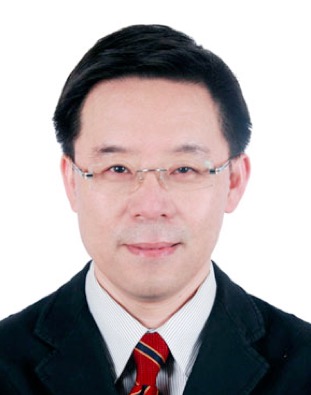Guo-Guang ZHAO

Guo-Guang ZHAO, M.D., Ph.D.
Professor, Department of Neurosurgery
Xuan Wu Hospital, China International Neuroscience Institute (China INI)
Director,Brain Injury evaluation center of Ministry of Health
PI, Beijing Institute for Brain Disorders (Epilepsy center)
Advisor, Commission on SEEG and Brain Mapping of CAAE
President, Xuan Wu Hospital (CMU), Beijing, China
Summary:
He devoted himself in neurosurgery and neuroscience since his graduation from Capital Medical College 27 years ago.
When receiving the comprehensive neurosurgical training in Beijing Xuan Wu hospital, he participated a national research project in Parkinson’s Disease (PD) treatment which acquired the national science and technology awards in 1996.
In 1998-2003, he started to focus on the functional neurosurgery after Beijing functional neurosurgery institute was established in Xuan Wu hospital. He completed outstand and pioneering works in PD, ET and Dystonia.
In the center of “Caudio Munari” Epilepsy and Parkinson’s Disease in Niguarda Ca’ Granda Hospital which is one of the most famous centers in the world, under the direction of Prof. Giorgio Lo Russo, he started his epilepsy surgery and research in Milano (Italy) in 2003-2004, particularly in stereotactic electroencephalography/SEEG.
Subsequently, as a council member of China Association Against Epilepsy/CAAE, he took part in introducing SEEG technique into China. He participated in the organization and development of epilepsy diagnosis and treatment platform in Xuan Wu hospital. He helped to build the first PET-MRI and finish the clinical verification in China. In the latest years, he is concentrating on the surgical treatment of pediatric intractable epilepsy. Also, with SEEG, he presents several national, provincial and ministerial research projects about the cerebral networks and minimally invasive treatment of epilepsy. Meanwhile, he involved himself in the interdisciplinary study of the Chinese Society for Cognitive Science.
Representative publications:
1. GG Zhao, F. Cardinale, M. Cossu, L. Tassi, G. Lo Russo, Feng Ling. Surgery for intractable epilepsy due to focal cortical dysplasia. Chinese Journal of Neurosurgery, 2006,22(6):351-354
2. Dahaba AA, Xue JX, Hua Y, Liu QH, Xu GX, Liu YM, Meng XF, Zhao GG*.The Utility of Using the Bispectral Index Vista for Detecting Cross Clamping Decline in Cerebral Blood Flow Velocity. Neurosurgery 67[ONS Suppl 1]: ons102-ons107, 2010
3. GG Zhao, Feng Ling. Stereo-electroencephalography (SEEG). Chin J Neurosurg, 2012, 28(3): 313-315
4. Yong-Zhi Shan, Xiao-tong Fan, Liang Meng, Yang An, Jian-kun Xu, Guo-guang Zhao. Treatment and outcome of epileptogenic temporal cavernous malformations. 2015;128(7). Chinese Medical Journal
5. Zhao GG, Shan YZ, DU JX, Ling F. Epilepsy surgery for tuberous sclerosis complex: a case report and literature review. Chin Med J (Engl). 2008 May 20;121(10):959-60.
6. Dahaba AA, Xue JX, Zhao GG, Liu QH, Xu GX, Bornemann H, Rehak PH, Metzler H. BIS-Vista™ Occipital Montage in Patients Undergoing Neurosurgical Procedures during Propofol Remifentanil Anesthesia.
Research Interests:
1. Cerebral functional evaluation (Brain Mapping): Multi disciplinary integrated platform for brain function evaluation to guarantee the epilepsy patients’ safety during clinical intervention with following methods as fMRI, MEG, PET/CT/MRI, Wada test, brain stimulation, awake surgery, anesthesia BIS monitoring and intra-operative ECoG.
2. SEEG in epilepsy surgery: using 3D neuronavigation to guarantee the quality and safety of electrodes implantation based on the multimodality brain imaging.
3. Pediatric epilepsy surgery: with prospective randomized and retrospective research projects about the prognosis of infant catastrophic epilepsy and cognitive development with optimized and standardized strategy.
4. Minimally invasive treatment for MRI-negative epilepsy or others: to confirm, reach and handle the key nodes of epilepsy origination in the cerebral networks based on the SEEG data analysis.
Awards and Honors:
1. Beijing science and technology progress awards in 1998.
2. U.S. National Parkinson’s Disease Foundation (NPF) formally listed Beijing Institute of Functional Neurosurgery (Xuan Wu hospital) as one of its worldwide clinical centers for P.D. treatment in 1999.
3. A visiting scholar award, Chinese-Italian government exchange scholarship project from 2003-2004.
4. Excellent performance in hospital management awarded by Chinese Hospital Association in 2012.
Publications:
1. Dahaba AA, Xue JX, Zhao GG, Liu QH, Xu GX, Bornemann H, Rehak PH, Metzler H
BIS-Vista™ Occipital Montage in Patients Undergoing Neurosurgical Procedures
during Propofol Remifentanil Anesthesia. Anesthesiology, 2010, V 112 • No 3: 645-651
2. YZ Shan, GG Zhao, JK Xu, F Ling. Clinicopathological features and surgical outcomes of intractable epielspy due to focal cortical dysplasia. Chin J Neurosurg, 2010,26(3): 206-208
3. GG Zhao, Feng Ling. Stereo-electroencephalography (SEEG). Chin J Neurosurg, 2012, 28(3): 313-315
4. GG Zhao, XT Fan, YZ Shan. Surgery for low grade neuronal-glial tumors and its epilepsy prognosis. Chinese J Clinicians, 2013, 7(14):251-254.
5. Yong-Zhi Shan, Xiao-tong Fan, Liang Meng, Yang An, Jian-kun Xu, Guo-guang Zhao. Treatment and outcome of epileptogenic temporal cavernous malformations. 2015;128(7). Chinese Medical Journal.

